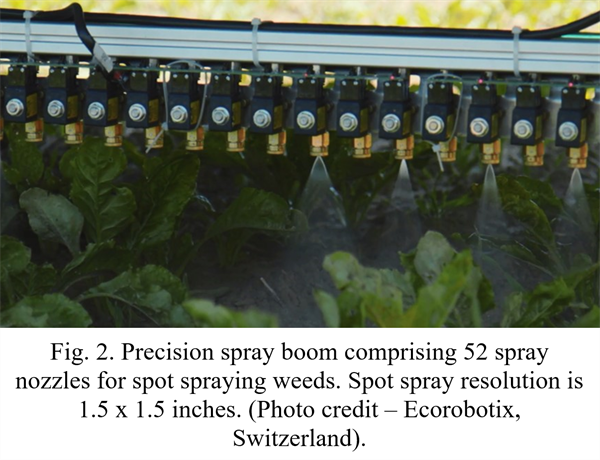Nov 11, 2020
2020 Advances in Automated Thinning and Weeding Technologies Update #3
There are many innovative automated weeding technologies coming out of Europe. One of these is the autonomous weeding robot being developed by Ecoroboti (Yverdon-les-Bains, Switzerland). The device is lightweight and solar powered. Early prototypes used a spider like, three-axis delta robot to precisely deliver herbicides to target weeds. Videos of the device were futuristic and intriguing to watch. The company has since moved on to a simpler weeding robot equipped with a fixed boom for spot spraying weeds (Fig. 1 & 2). The autonomous robot has some specifications that are plausible for use in Arizona vegetable production. Machine travel speed is 2.2 mph and work rate is 15 acres/day (10 hour day). Spot spray resolution is reasonable at 2.5 inch2 (1.5 x 1.5 inch). This is accomplished using a series of 52 nozzles mounted on an 80 inch wide boom (Fig. 2). The machine uses computer imaging and artificial intelligence for crop/weed differentiation to identify and target weeds.
This past summer, the system was tested in sugar beets in Germany. Results showed the system correctly sprayed about 80% of the weeds. For a first time, real-world, field scale test, this outcome is encouraging.
There are some limitations however. According to product literature, the machine’s artificial intelligence system will identify a crop plant as a weed approximately 5% of the time. Given the high value of vegetable crops, killing 5% of the crop as a trade-off for robotically controlling weeds is probably not viable. It should be noted that this level of crop/weed recognition performance is consistent with other artificial intelligence-based systems reported in the literature.
Don’t give up hope though. This type of technology is advancing rapidly, and may become feasible in the future. Computing speed and sensor capabilities are advancing all the time. A review of literature indicates that systems that combine 3-D morphology, optical color and accurate location data with deep learning techniques may be a viable approach to reliably differentiate crops from weeds. It will be interesting and exciting to watch this technology as it develops. That’s for sure.
As I have mentioned before, automated thinning and weeding technologies are advancing at a very rapid pace. If you know of a new technology that would be of interest and appropriate for this newsletter, please feel free to contact me.


To contact Mark C. Siemens go to:
siemens@cals.arizona.edu











